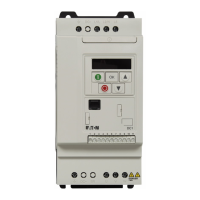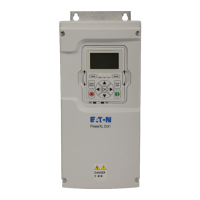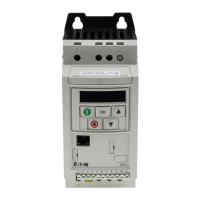6 Drives control
6.3 Motor
DC1 variable frequency drive 12/13 MN04020003Z-EN www.eaton.com 111
6.3.3 U/f characteristic curve
The inverter in the DC1 variable frequency drive works with sinusoidal pulse
width modulation (PWM). The IGBTs are switched with two control methods
based on V/Hz control:
U/f (P-10 = 0)
• Frequency control (Hz),
• Parallel Connection of several motors,
• Large power difference (P
FU
>> P
Motor
),
• Switching in the output.
U/f with slip compensation (P-10 > 0)
• Speed control (min
-1
, rpm) with slip compensation,
• Single operation (only one motor),
maximum one power rating smaller P
FU
>P
Motor
,
• High torque (requirement: exact motor data for the motor model).
The U/f-characteristic curve (voltage/frequency characteristic curve) desig-
nates a control process for the variable frequency drive, with which the
motor voltage is controlled in a certain ratio to the frequency. If the voltage/
frequency ratio is constant (linear characteristic curve), the magnetizing flux
and the torque curve of the connected motor is virtually constant.
In a standard application, the benchmark values for the V/Hz characteristic
curve match the rated operational data of the connected motor (see the
motor's rating plate):
• Output voltage P-28 = Nominal motor voltage P-07
• Cut-off frequency P-29 = Rated motor frequency P-09 = Maximum
frequency P-01
Figure 66: U/f-characteristic curve
→
The rating data of the U/f-characteristic curve is assigned auto-
matically and corresponds with the values of parameter P-07
(nominal motor voltage) and P-09 (rated motor frequency).
linear
P-28 = 0, P-29 = 0
parameterizable
P-28 > 0, P-29 > 0
[%]
U
f
[Hz]
P-11
P-07
P-02
P-09
U
[%]
f
[Hz]
P-11
P-28
P-07
P-09
P-29

